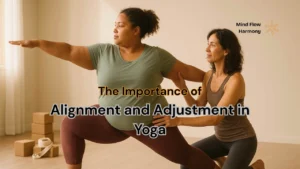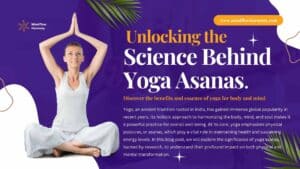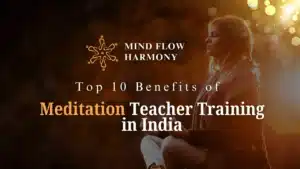Being the main part of Ashtanga Yoga, you focus on three main elements in the Tristhana Method like posture (asana), breathing (ujjayi pranayama)and gaze (drishti). These elements work together closely to form the base of a mindful Ashtanga practice.
Your body and mind start to work in harmony when proper posture, steady breathing and focused gaze bring together. This will keep you calm and focused. Also, it strengthens and purifies your body from inside. The Tristhana Method brings balance to your physical and mental practice which help you move deeper into awareness and mindfulness each time you step onto the mat.
What is the Tristhana?
Tristhāna simply refers to three places of focus. These are usually breath, bandha and drishti in Ashtanga Yoga. Some people also include asana (posture) instead of bandha because breath and bandha are so closely connected. No matter how you define it, all parts of Tristhāna serve one purpose which is to train the mind to focus.
As you go deeper into working with the breath, bandha, and drishti, your ability to concentrate naturally grows. This focus becomes the base for higher stages of yoga like meditation.
Simply doing the physical poses or the Primary Series is not enough in Ashtanga practice. True practice is when you keep steady awareness of breath, bandha and drishti throughout the sequence. This is obviously where confusion can start as people often wonder what the right way to breathe is or how exactly to apply the bandhas and drishti. The truth is that these skills take time, awareness and constant practice to understand deeply.
Learn 200 Hour Ashtanga Yoga Teacher training in Rishikesh
The Tristhana in Ashtanga Yoga
Have a look below to know how each part of the Tristhana method works and how together they create balance in Ashtanga practice.
Asana – The Physical Foundation
The first part of Tristhana is asana which means the physical postures of yoga. Every posture is linked in a flowing sequence In Ashtanga which is known as vinyasa. The practice usually starts with simple movements and slowly moves toward much more challenging poses as the body becomes stronger and flexible.
How Asana Creates Balance?
Asanas make your muscles strong, tone your body and improve flexibility. But they mainly balance your body’s energy. Each pose targets specific muscles and organs which improve your blood circulation and give internal health. For example, forward bends calm the mind, backbends energize the body and twists detoxify internal organs.
It has been noticed that changes happen not only in your physical strength but also in your mental stability through consistent asana practice. The discipline of maintaining a regular practice teaches patience and self control. You will learn to stay calm even in challenging postures which reflects your handling of challenges in life.
Asanas also keep the practitioner connected with the ground. The mind naturally becomes calm and focused when the body feels strong. This physical stability creates the foundation for mental balance and it is indeed the first step toward harmony.
Pranayama – The Power of Breath

The second aspect of Tristhana is pranayama or the control of breath. In Ashtanga, this mainly refers to ujjayi breathing which is a deep and steady breath. It produces a gentle ocean-like sound at the back of the throat.
This kind of breathing is done through the nose with the closed mouth. Each inhale and exhale should be of equal length also. You should keep the breath smooth, even and continuous throughout the whole practice.
How Pranayama Creates Balance?
Breathing is life. The way you breathe in yoga shows the state of your mind. Shallow and uneven breathing usually reflects that your mind is restless or anxious. Deep and steady breathing points out calmness and focus. Your mind will be trained to stay steady and present by maintaining awareness of the breath during practice.
Ujjayi breath also generates internal heat which detoxifies the body and increases energy. This inner warmth makes the muscles highly flexible and reduces the risk of injury. It also cleanses the nervous system which improve both physical and emotional balance.
Breath mainly connects the body and the mind. When the mind wanders it will be brought back by focusing on the breath. This develops mindfulness overtime. In this way, pranayama balances the physical energy of the body but also the emotional and mental energy which lead to inner harmony.
Drishti – The Focus of the Mind
The third element of Tristhana is drishti or gaze. Each pose in Ashtanga Yoga has a certain drishti point like looking at the tip of the nose, the thumb, the navel or upward to the sky. The purpose of drishti is to direct the eyes and the mind toward a single focus point.
How Drishti Creates Balance?
The mind follows where your eyes go. The mind also becomes distracted when the eyes move restlessly around. Drishti teaches you to control this wandering tendency. By fixing your gaze, mind get the training to stay steady, calm and concentrated.
Drishti also encourages your inner focus. When you focus the gaze, you are less distracted by the external world and highly connected to your inner experience. This helps develop dharana or concentration over time which is one of the key limbs of yoga.
Practicing drishti also builds self awareness. You will begin to notice your thoughts, emotions and reactions during practice. And you slowly cultivate a peaceful and balanced state of mind by noticing these patterns without judgment.
Conclusion
All parts of tristhāna are points of concentration. They let you move deep into the full path of Ashtanga’s eight limbs with time and dedication. These elements like breath, bandha and drishti build the foundation. And then naturally leads you toward pratyahara (withdrawal of senses), dharana (concentration), and dhyana (meditation).
The Primary Series is where you get trained to connect with these three elements. It is not simply about doing poses, breathing or focusing your gaze separately. This will bring them all together. You actually plant the seeds of tristhāna and nurture them in this series until they turn to a complete and balanced yoga practice.








